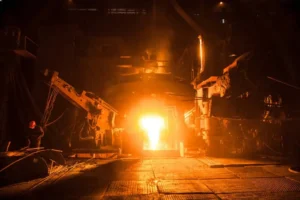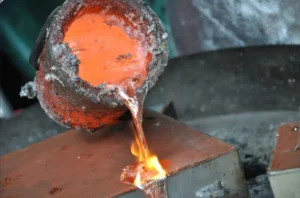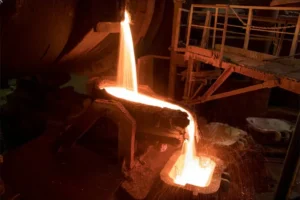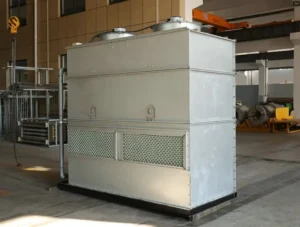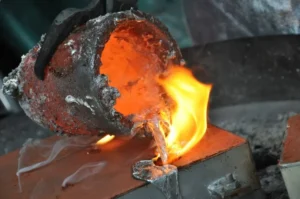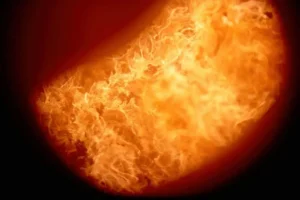Là một công nghệ luyện kim loại rất hiệu quả và sạch sẽ, Lò cảm ứng đóng một vai trò quan trọng trong ngành công nghiệp luyện kim và đúc hiện đại, Nhờ vào nguyên tắc gia nhiệt điện từ độc đáo của nó. Từ vật liệu sắt và thép số lượng lớn đến kim loại quý tốt, Việc áp dụng các lò cảm ứng kéo dài các lĩnh vực xử lý kim loại khác nhau. Tuy nhiên, phù hợp với các tính chất vật lý và hóa học riêng biệt của các kim loại khác nhau, Các điểm kỹ thuật và thách thức phải đối mặt trong quá trình luyện kim cũng khác nhau đáng kể.
Gang đá: Nghệ thuật cân bằng chi phí và chất lượng
Lò cảm ứng đã trở thành thiết bị chính để sản xuất gang, đặc biệt là gang cao cấp. Ưu điểm của nó nằm ở tốc độ nóng chảy nhanh, Kiểm soát nhiệt độ chính xác, và dễ dàng điều chỉnh thành phần của kim loại nóng chảy.
Điểm kỹ thuật
- Quản lý và tỷ lệ phí: Để đảm bảo hiệu suất cuối cùng của gang, Có những yêu cầu nghiêm ngặt đối với tỷ lệ và chất lượng của các vật liệu tính phí như người chạy và riser, Thép phế liệu, Sắt lợn, Hộp hàm, và Ferrosilicon. Tỷ lệ thép phế liệu được sử dụng, đặc biệt, ảnh hưởng trực tiếp đến mức tiêu thụ năng lượng và chất lượng luyện kim của sắt nóng chảy.
- Khả năng tan chảy và quá nóng: Lò nung cảm ứng có thể nhanh chóng tăng nhiệt độ của sắt nóng chảy lên hơn 1500 ° C. Chất quá nhiệt hiệu quả giúp loại bỏ di truyền than chì và thúc đẩy sự hình thành than chì loại A, do đó cải thiện các tính chất cơ học của việc đúc.
- Điều trị tiêm chủng: Đây là một bước quan trọng để xác định hiệu suất của gang. Thêm chất cấy vào sắt nóng chảy trước khi khai thác làm tăng các vị trí tạo mầm cho than chì, Tinh chỉnh cấu trúc hạt, và ngăn chặn sự hình thành sắt ướp lạnh (Sắt trắng) và than chì chưa được kiểm soát.
- Lựa chọn vật liệu lót: Chọn đúng lớp lót acidic, trung lập, hoặc cơ bản - rất quan trọng và phụ thuộc vào lớp gang bị nấu chảy (ví dụ., Sắt xám, sắt dễ uốn) và nhiệt độ nóng chảy. Một lớp lót phù hợp có thể chống lại sự ăn mòn hóa học và xói mòn cơ học từ sắt nóng chảy ở nhiệt độ cao.
Thách thức
- Mất nguyên tố và kiểm soát thành phần: Dưới nhiệt độ cao và khuấy điện từ, Các yếu tố trong sắt nóng chảy như carbon (C), silic (Và), và mangan (Mn) Liệu oxy hóa và bị mất. Cách dự đoán chính xác và bù đắp cho sự mất mát nguyên tố này là một thách thức lớn trong việc duy trì thành phần hóa học ổn định trong các vật đúc.
- Hấp thụ khí và vùi: Rỉ sét và độ ẩm do các vật liệu điện tích mang lại, cũng như nitơ (N₂) và oxy (O₂) Từ bầu không khí, có thể dễ dàng hòa tan trong sắt nóng chảy, dẫn đến các khuyết tật đúc như độ xốp khí và lỗ kim. Ngoài ra, Các thể vùi phi kim loại như oxit được tạo ra trong quá trình luyện kim rất khó loại bỏ hoàn toàn.
- Xu hướng cho siêu lạnh: So với lò nung cúp, Sắt nóng chảy từ lò cảm ứng có mức độ siêu lạnh lớn hơn, Làm cho nó dễ bị hình thành các hình thái than chì không mong muốn như loại D và loại E, do đó có sự phụ thuộc cao hơn vào điều trị tiêm chủng.
- Tiêu thụ năng lượng và kiểm soát chi phí: Một cấu trúc điện tích không hợp lý (ví dụ., Quá nhiều nhẹ và mỏng manh) hoặc hoạt động không phù hợp (ví dụ., Giữ ở nhiệt độ thấp trong thời gian dài) có thể làm tăng đáng kể mức tiêu thụ điện trên mỗi tấn sắt, tác động đến hiệu quả kinh tế.

Thép không gỉ luyện: Trận chiến để bảo vệ các yếu tố hợp kim
Lò nung cảm ứng rất phù hợp để sản xuất nhiều loại và các lô thép không gỉ nhỏ do tính linh hoạt cao của chúng.
Điểm kỹ thuật
- Vật liệu điện tích tinh khiết cao: Bản thân lò cảm ứng không có khả năng tinh chế, Vì vậy, độ tinh khiết của vật liệu điện tích là vô cùng quan trọng. Cần sử dụng thép không gỉ phế liệu, trả lại, và các hợp kim như crom và niken có hàm lượng tạp chất thấp và thành phần đã biết.
- Kiểm soát oxy hóa: Chìa khóa để luyện thép không gỉ đang kiểm soát việc mất các yếu tố dễ oxy hóa, đặc biệt là crom (Cr). Điều này thường đạt được bằng cách che phủ bể nóng chảy bằng một cái xỉ bảo vệ, Kiểm soát bầu không khí lò, hoặc tiến hành sự tan chảy trong lò cảm ứng chân không.
- Kiểm soát nhiệt độ chính xác: Thép không gỉ có điểm nóng chảy cao và nhạy cảm với nhiệt độ đổ. Khả năng kiểm soát nhiệt độ chính xác của lò nung cảm ứng là một lợi thế, ngăn chặn hiệu quả quá trình oxy hóa nguyên tố nghiêm trọng và sự hình thành hạt thô gây ra bởi nhiệt độ quá cao.
- Khả năng chống ăn mòn của lớp lót: Xỉ được tạo ra trong quá trình luyện kim không gỉ có độ ăn mòn cao, Đặt nhu cầu cao vào độ khúc xạ và điện trở hóa học của vật liệu lót (thường là magiê- hoặc dựa trên alumina-Magnesia).
Thách thức
- Tốc độ phục hồi của crom (Cr): Crom là yếu tố lõi oxy hóa quan trọng và dễ dàng nhất trong thép không gỉ. Thách thức trung tâm trong việc giảm chi phí và đảm bảo chất lượng là làm thế nào để giảm thiểu sự mất oxy hóa của crom và tối đa hóa tốc độ phục hồi của nó trong quá trình luyện kim.
- Thiếu khả năng tinh chỉnh: Không giống như lò hồ quang điện-AOD (Argon oxy hóa) Quá trình song công, Một lò nung cảm ứng không thể loại bỏ các yếu tố tạp chất khỏi thép nóng chảy. Vì thế, Chất lượng của vật liệu điện tích trực tiếp xác định chất lượng của sản phẩm cuối cùng. Đối với thép không gỉ cao cấp đòi hỏi phải kiểm soát nghiêm ngặt các tạp chất có hại như phốt pho (P) và lưu huỳnh (S), Lò nung cảm ứng phải đối mặt với những thách thức đáng kể.
- Tính đồng nhất của thành phần hợp kim: Mặc dù khuấy điện từ giúp đồng nhất hóa thành phần, Đảm bảo phân phối đồng đều các yếu tố hợp kim với sự khác biệt mật độ lớn vẫn đòi hỏi một quy trình hoạt động được thiết kế tốt.
Khóa đồng và nhôm: Kiểm tra kép về độ dẫn và quá trình oxy hóa
Sự luyện đồng của đồng và nhôm và hợp kim của chúng rất phổ biến trong các ứng dụng lò nung cảm ứng, Nhưng các tài sản tương ứng của chúng mang lại những khó khăn kỹ thuật khác nhau.
Hợp kim đồng và đồng luyện đồng
- Điểm kỹ thuật
- Lựa chọn của Tần số trung bình Nguồn cấp: Đồng có điện trở rất thấp và độ dẫn điện tuyệt vời. Để đạt được hiệu quả nóng chảy lý tưởng, nguồn cung cấp năng lượng tần số trung bình thường được chọn để sử dụng “Hiệu ứng da,” Năng lượng tập trung vào bề mặt điện tích đồng để nóng chảy.
- Lựa chọn lót: Kiểu gỗ than chì hoặc cẩm thạch bằng đất sét thường được sử dụng để nấu chín đồng nguyên chất hoặc đồng thau, Trong khi các vật liệu lót chống ăn mòn hơn là cần thiết để nấu các hợp kim như đồng.
- Ngăn chặn quá trình oxy hóa và hấp thụ khí: Đồng nóng chảy rất dễ bị oxy hóa và hấp thụ khí (đặc biệt là oxy và hydro) ở nhiệt độ cao, có thể dẫn đến các vùi oxit và độ xốp trong quá trình đúc. Vì thế, Điều quan trọng là sử dụng các tác nhân bao phủ như than củi hoặc than chì để bảo vệ bề mặt và kiểm soát nhiệt độ và thời gian nóng chảy.
- Thách thức
- Hiệu quả thấp do độ dẫn cao: Độ dẫn điện tuyệt vời của đồng dẫn đến hiệu quả sưởi cảm ứng tương đối thấp, đặt nhu cầu cao hơn vào việc thiết kế cuộn dây cảm ứng và sự phù hợp của nguồn cung cấp điện.
- “Bệnh hydro” Vấn đề: Khi đồng nóng chảy oxy hóa chất hóa rắn trong bầu không khí giảm, Hydro bị hòa tan phản ứng với oxit cuprus để tạo thành hơi nước, gây ra vết nứt bên trong, một hiện tượng được gọi là “Bệnh hydro.” Đây là một rào cản kỹ thuật lớn khi nấu chảy đồng, Đặc biệt là đồng không có oxy.
Hợp kim nhôm và nhôm nóng
- Điểm kỹ thuật
- Kiểm soát nhiệt độ chính xác: Nhôm có điểm nóng chảy thấp nhưng độ dẫn nhiệt cao, Làm cho nhiệt độ dễ dàng mất kiểm soát. Nhiệt độ quá mức sẽ làm trầm trọng thêm quá trình oxy hóa và hấp thụ hydro của nhôm nóng chảy.
- Khử khí và loại bỏ: Nhôm nóng chảy dễ dàng hấp thụ hydro và dễ dàng hình thành các vùi như alumina (Al₂O₃). Vì thế, Sau khi tan chảy, Một điều trị tinh chế hiệu quả là điều cần thiết, Sử dụng khí trơ (như argon) các tác nhân tinh chế sủi bọt hoặc rắn để loại bỏ hydro và dross.
- Ngăn ngừa ô nhiễm sắt: Nhôm nóng chảy có thể ăn mòn các dụng cụ và thiết bị chứa sắt, dẫn đến nội dung sắt quá mức làm suy giảm các thuộc tính của hợp kim. Vì thế, Các công cụ phải có lớp phủ bảo vệ tốt hoặc được làm bằng vật liệu phi kim loại.
- Thách thức
- Cao Độ hòa tan của hydro: Độ hòa tan của hydro trong nhôm lỏng lớn hơn nhiều so với nhôm rắn. Kết quả là, nó dễ dàng kết tủa trong quá trình hóa rắn để tạo thành p mất, đó là khiếm khuyết phổ biến nhất trong đúc nhôm.
- Xử lý Phim oxit: Một màng oxit nhôm dày đặc nhanh chóng hình thành trên bề mặt nhôm. Mặc dù bộ phim này có thể ngăn chặn quá trình oxy hóa kim loại ở một mức độ nào đó, Nếu bộ phim bị hỏng bị trộn lẫn vào sự tan chảy trong quá trình nấu chảy, Nó sẽ hình thành các khiếm khuyết nghiêm trọng.
- Niêm mạc “Làm ướt” Vấn đề: Nhôm nóng chảy có thể phản ứng với và “ướt” một số vật liệu lót, Làm cho việc loại bỏ xỉ trở nên khó khăn và có khả năng làm hỏng lớp lót. Chọn vật liệu chịu lửa đặc biệt chống lại “làm ướt” là rất quan trọng.
Vàng và bạc nấu chảy: Sự theo đuổi cuối cùng của giá trị và sự thuần khiết
Đối với các kim loại quý như vàng và bạc, Mục tiêu chính của việc luyện kim là giảm thiểu tổn thất và đảm bảo độ tinh khiết.
Điểm kỹ thuật
- Cây cuốc cao cấp cao: Thủ than có độ tinh khiết cao hoặc gốm gốm (chẳng hạn như thạch anh) phải được sử dụng để ngăn chặn tạp chất từ vật liệu nồi nấu kim loại làm ô nhiễm kim loại quý nóng chảy.
- tan chảy nhanh: Tốc độ cao và nhiệt tập trung của hệ thống sưởi cảm ứng rút ngắn đáng kể thời gian nóng chảy, do đó làm giảm sự mất mát của kim loại quý ở nhiệt độ cao.
- Kiểm soát nhiệt độ chính xác và khuấy: Kiểm soát nhiệt độ chính xác có thể ngăn ngừa mất kim loại do nhiệt độ quá cao. Hiệu ứng khuấy điện từ có lợi cho việc tạo ra các hợp kim đồng nhất (như vàng karat) bằng cách trộn đồng đều các thành phần khác nhau.
- Bảo vệ kín hoặc không khí: Đối với việc nấu chảy đặc biệt tốt hoặc không khí nhạy cảm với bầu không khí, Quá trình này có thể được thực hiện trong chân không hoặc dưới bầu không khí khí trơ trong lò nung cảm ứng để loại bỏ hoàn toàn.
Thách thức
- Kiểm soát mất kim loại: Vàng và bạc cực kỳ có giá trị, và bất kỳ tổn thất nhỏ nào do bắn tung tóe, bay hơi, hoặc bị xáo trộn bởi xỉ sẽ dẫn đến tổn thất kinh tế đáng kể. Mỗi bước của hoạt động phải được thực hiện một cách cực kỳ quan tâm.
- Đảm bảo tinh khiết: Trong quá trình luyện kim, Bất kỳ ô nhiễm nào từ tạp chất bên ngoài phải được ngăn chặn nghiêm ngặt. Điều này đặt ra nhu cầu cực kỳ cao về nguồn của vật liệu điện tích, Sự sạch sẽ của các công cụ, và môi trường nấu chảy.
- Các lô nhỏ và tính linh hoạt: Khai thác kim loại quý thường liên quan đến các lô nhỏ và nhiều giống, đòi hỏi các thiết bị lò nung cảm ứng là linh hoạt và cho phép các thay đổi bình tĩnh nhanh chóng thích nghi với các công việc luyện kim khác nhau.
Với những lợi thế độc đáo của nó, Lò cảm ứng đã tìm thấy vị trí của nó trong một loạt các ứng dụng luyện, Từ sắt và thép thông thường đến kim loại quý vô giá. Tuy nhiên, Chìa khóa cho ứng dụng thành công của nó nằm ở sự hiểu biết sâu sắc và phản ứng hiệu quả đối với các thách thức cụ thể được đưa ra bởi các kim loại khác nhau trong quá trình luyện kim. Cho dù đó là kiểm soát chất lượng luyện kim của gang, bảo vệ các yếu tố hợp kim trong thép không gỉ, Các vấn đề oxy hóa và hấp thụ khí trong đồng và nhôm, hoặc sự đảm bảo tổn thất tối thiểu và độ tinh khiết cao đối với kim loại quý, đạt được hiệu quả, chất lượng cao, và nấu chảy kinh tế đòi hỏi sự kết hợp của kiến thức khoa học vật liệu sâu, Công nghệ thiết bị nâng cao, và quản lý quy trình tinh tế.


